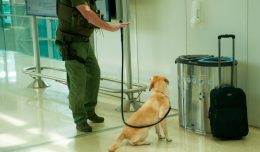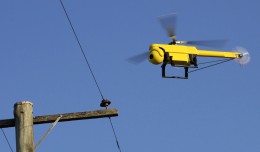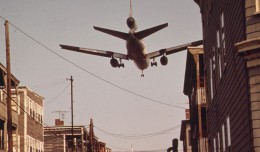(Editor’s note: this is the second and concluding installment of a series by Patrick Smith. See part one here.)
One day in 2006 my mother caused a small commotion at a checkpoint at Boston-Logan after screeners discovered a container of homemade tomato sauce in her bag. What with the preponderance of spaghetti grenades and lasagna bombs, we can all be proud of their vigilance; as a liquid, tomato sauce is in clear violation of TSA’s carry-on statutes. But this time there was a wrinkle: the sauce was frozen.
The icy red block had the guards in a scramble. Liquid, solid, gel, what was it? A supervisor was called over to assess things. He spent several moments stroking his chin before, drawing from an exquisite knowledge of refrigeration, he observantly sized things up. “It’s not a liquid right now,” he noted. “But it will be soon.”
“Please,” urged my mother. “Please don’t take away my dinner.”
Lo and behold, they did not. Whether out of confusion, sympathy, or embarrassment, she was allowed to pass with her murderous marinara.
And this got me thinking. Why can’t TSA exhibit common sense now and then? If we’re to believe that TSA screeners are well-trained professionals, as the agency maintains, why can they not handle the responsibility of an occasional judgment call? Why can’t they be empowered to allow some on-the-spot decision-making? If a screener is shown a six-ounce tube of toothpaste that is obviously only half full, does it really need to be taken and flipped into the waste bin, as currently happens 90 percent of the time?
“Our screeners are allowed to exercise leeway in some cases,” a TSA spokesperson told me. “They have the training, and the obligation, to exercise discretion.” Maybe, but the tomato sauce incident notwithstanding, I’m not seeing much leeway and discretion. I’m seeing a draconian obsession with the exactness of container volumes and the dimensions of objects, up to and including whether a pilot’s tiny knife has serrations on its blade, as if they alone could be the difference between unsafe and safe. Enforcement of this kind transcends mere tedium and becomes downright unsafe. Maybe you’ve heard the story about a test in which TSA screeners are presented with a suitcase containing a mock explosive device with a water bottle nestled next to it? They ferret out the water, of course, while the bomb goes sailing through.
Notice too the uniforms adopted by TSA. Screeners are now called “officers” and they wear blue shirts and silver badges. Not by accident, the shirts and badges look exactly like the kind worn by police. Mission-creep, this is called. In fact TSA workers do not hold law enforcement power as such — much as they have done a good job of fooling people into believing otherwise. TSA holds the authority, legitimately, to inspect your belongings and prevent you from passing through a checkpoint. It does not have the authority to detain you, interrogate you, arrest you, force you to recite the Pledge of Allegiance, or otherwise compromise your rights. Both TSA and the traveling public need to remember this.
In 2010 things were taken to the next level with the introduction of full-body scanners at US airports. This is the latest and one of the more disheartening developments in our long war on the abstract noun called terrorism. What’s next, we have to wonder? Where will it end? Or is this the end?
We’re asked to believe the body scanners are a critical tool, yet the strategy behind their deployment makes no sense. You’ve got a scanner at one checkpoint, but no scanner at the one right next to it; scanners at some terminals, but not at others. Are terrorists that stupid? And what about overseas? If somebody is going to sneak a bomb through a checkpoint, it is far more likely to happen someplace in Asia, Africa, South America or the Middle East than it is in Peoria, Wichita or Cleveland. But domestically is where you find the majority of scanners. It’s easy to be cynical. Are these machines really in the interest of safety? Is that what this is about? Or is it about the corporations who stand to make billions of dollars in their design and deployment? It’s questionable whether the scanners are making us safer. But rest assured they’re making somebody wealthy.
When asked to pass through a scanner, I opt out and take the pat-down instead. I don’t opt out because of worries about radiation. I do it for the reasons above, and because I find it appalling that passengers are asked to pose naked in order to board an airplane. A decade ago, nobody would have believed such a thing was possible, and the suggestion would have been met with howls of outrage. But here it has come to pass, and our reaction, aside from one or two muffled complaints, has been a sheep-like acquiescence.
No less frustrating is the strained notion that, beginning with the events of September 11, air travel suddenly entered a new age of danger and threat. The grandiosity of the 2001 attacks, with their Hollywood thriller plot line and operatic fireballs, has gummed up our memories. We talk of the “post-9/11 era,” whereas politically motivated violence against civil aviation has been with us for decades. In fact, we see it a lot less often than we used to. The 1970s through the 1990s were a sort of golden age of air crimes rife with hijackings and bombings. In the five-year span between 1985 and 1989 there were no fewer than six major terrorist attacks against commercial planes or airports, including the Libyan-sponsored bombings of Pan Am 103 and UTA 772; the bombing of an Air India 747 that killed 329 people; and the saga of TWA flight 847. Flight 847, headed from Athens to Rome in June of 1985, was hijacked by Shiite militiamen armed with grenades and pistols. The purloined 727 then embarked on a remarkable, 17-day odyssey to Lebanon, Algeria, and back again. At one point passengers were removed, split into groups, and held captive in downtown Beirut. The photograph of TWA captain John Testrake, his head out the cockpit window, collared by a gun-wielding terrorist, was broadcast worldwide and became an unforgettable icon of the siege.
I say “unforgettable” but that’s just the thing. How many Americans remember flight 847? It’s astonishing how short our memories are. And partly because they’re so short, we are easily frightened and manipulated. Imagine TWA 847 happening tomorrow. Imagine six successful terror attacks against planes in a five-year span. The airline industry would be decimated, the populace frozen in fear. It would be a catastrophe of epic proportion — of wall-to-wall coverage and, dare I suggest, the summary surrender of important civil liberties. What is it about us, as a society, that has made us so unable to remember, and unable to cope?
But all right, enough of what we shouldn’t be doing. What about things we should be doing? If I’m going to spend all this time complaining, it’s only fair that I offer up some solutions, no?
Well, airport security overall ought to be scaled back into a leaner but more focused operation. I wouldn’t say that we have too much security, necessarily, but we certainly have too much in the wrong places, out of synch with the hierarchy of threat. First up, every dime currently being spent looking for pointy objects, double-checking people’s IDs and confiscating innocuous liquids needs to be reallocated.
The primary threat to commercial aviation is, was, and shall remain bombs. Therefore every piece of luggage, both checked and carry-on, as well as cargo, ought to be scrutinized for explosives. This already happens, officially, though I reckon we could be doing a more thorough job of it, with a stronger emphasis on airports outside the United States. The likeliest point of entry for a bomb is not Omaha or Tucson, and I’d suggest shifting a good 35 percent of TSA resources to locations overseas. If that should require some touchy negotiations with foreign airport authorities, so be it.
And like it or not, the time has come to put greater emphasis on passenger profiling. Profiling is a dirty word to some, but it needn’t be a one-dimensional preoccupation with skin color or national origin. Indeed, as security specialists will tell you, racial or ethnic profiling doesn’t work. Routine is weakness, and the more predictable our methods, the easier they are to foil. Effective profiling uses a multi-point approach that takes in a wide range of characteristics, both tangible and behavioral. TSA has in fact been training staff in the finer points of behavioral pattern recognition. That’s good, though for the time being screeners are a lot more adept at picking out scissors and shampoo bottles than picking out terrorists.
The International Air Transport Association (IATA) has proposed a plan in which passengers would be categorized into one of three risk groups, and then screened accordingly. Biometric proof-of-identity, such as a fingerprint or encoded passport, will be checked against a stored profile containing various personal data, and also against watch lists. This, together with flight booking data will determine which of three lines a traveler is assigned to. Those in the first line would receive little more than a cursory bag check. Those in the second line get a slightly closer look, while those in the third would face an enhanced inspection similar to the current TSA procedures. This wouldn’t be perfect — and like many people, I get a little nervous when I hear the words “biometric” and “profile containing various personal data” — but it’s maybe the best idea yet when it comes to restoring sanity to airport security. IATA says that an early version of the three-tiered system could be up and running in under three years.
That is, if governments cooperate. IATA is making sense, but I’m afraid it lacks the clout of the US Department of Homeland Security, the federal branch under whose auspices TSA operates. Enacting serious change would take, more than anything else, the political will and courage of our leaders in Congress. We have thus far seen little political opposition, bipartisan or otherwise, to TSA’s squandering of our time and money. While I hate to sound like a conspiracy theorist, our leaders talk and act as if they enjoy the status quo, unwilling to disenfranchise any facet of what has become a vast and profitable security-industrial complex.
To be fair, there are plenty of bright and resourceful people at TSA who know a lot more about the challenges of airport security than I ever will. And they openly admit that a philosophical change is needed — a shift toward focusing on passengers themselves rather than on their belongings. This, they understand, is the only viable strategy for the future. But TSA is, in the end, a bureaucracy. No doubt it sees the IATA proposal, and others like it, as a threat to its funding and authority. This was an agency created in haste, granted considerable powers and relatively little accountability. Any idea, however beneficial, faces an uphill battle against such a potent government entity, especially when aided and abetted by a lethargic populace and an irresponsible media.
What TSA has signed off on are third-party programs, run by outside contractors, in which passengers submit biometric and personal data in exchange for expedited screening — for a fee. Count me among those who find these programs objectionable. Rather than fixing the problem, citizens can pay money and cut to the front of the line. Your taxes will continue to support a dysfunctional system, and now you can pay even more to circumvent that system. This is progress?
It doesn’t have to be this way. The solution is out there. Give us good intelligence-gathering and law enforcement, together with on-site random searches, thorough explosives scanning, and smartly managed profiling, and what have we got? A security strategy that is frankly pretty good.
As good as it can be, anyway. Somewhere beneath all of this rests the uncomfortable, seldom acknowledged fact that no matter how hard we try, we’re never going to make flying completely safe. Neither all the determination in the world nor the most sweeping regulations we dare codify will outsmart a cunning enough saboteur. Sound, competent security greatly improves our chances, whether against the concoctions of a single deranged individual or organized terror from the caves of Central Asia. But with every new technology and pledge of better safeguards, we correspondingly inspire the imaginations of those who wish to defeat us. There will always be a way to skirt the system.
This brings us to a third fundamental flaw in our approach, whereby we refuse to acknowledged that the real job of keeping terrorists away from planes is not the job of airport screeners in the first place. Rather, it’s the job of government agencies and law enforcement. The grunt work of hunting down terrorists takes place far off stage, relying on the diligent work of cops, spies, and intelligence officers. Air crimes need to be stopped in the planning stages. By the time a terrorist gets to the airport, chances are it’s too late. And the rage of angry radicals, dangers as it may be, is a long-term anthropological mission to be dealt with separately; it is not an excuse to turn airports into fortresses and subvert freedoms.
In the end, I’m not sure which is more distressing, the inanity of the existing regulations or the average citizen’s acceptance of them. There ought to be a tide of opposition rising up against this mania. Where is it? At its loudest, the voice of the traveling public is one of grumbly resignation. The op-ed pages are silent, the pundits have nothing to say.
The airlines, for their part, are in something of a bind. That carriers and industry advocates seem content with such high levels of aggravation among their customers suggests a business model that is almost surreally masochistic and self-destructive. On the other hand, imagine the outrage in certain circles should airlines be caught lobbying for what is perceived to be a dangerous abrogation of security and responsibility—even if it’s not. Carriers caught plenty of flak, almost all of it unfair, in the aftermath of September 11th. Understandably, they no longer want that liability.
How we got to this point is an interesting study in reactionary politics, fear mongering, and a disconcerting willingness of the public to accept almost anything, no matter how illogical, inconvenient, or unreasonable, in the name of security. Conned and frightened, what we get is not actual security, but security spectacle. The idea that this spectacle “helps travelers to feel better” is about its only excuse, and is hardly enough justification to keep it funded and running. And although a high percentage of passengers, along with most security experts, would concur that it leaves us no safer, and perhaps even increases our risks, there has been little to no protest. In that regard, maybe, we’ve gotten exactly the system we deserve.
This article was originally published on AskThePilot.com and is used here with the author’s permission. Patrick Smith is an airline pilot, author, and host of AskThePilot.com. His new book is COCKPIT CONFIDENTIAL: Everything You Need to Know About Air Travel. He lives in Somerville, Massachusetts.







